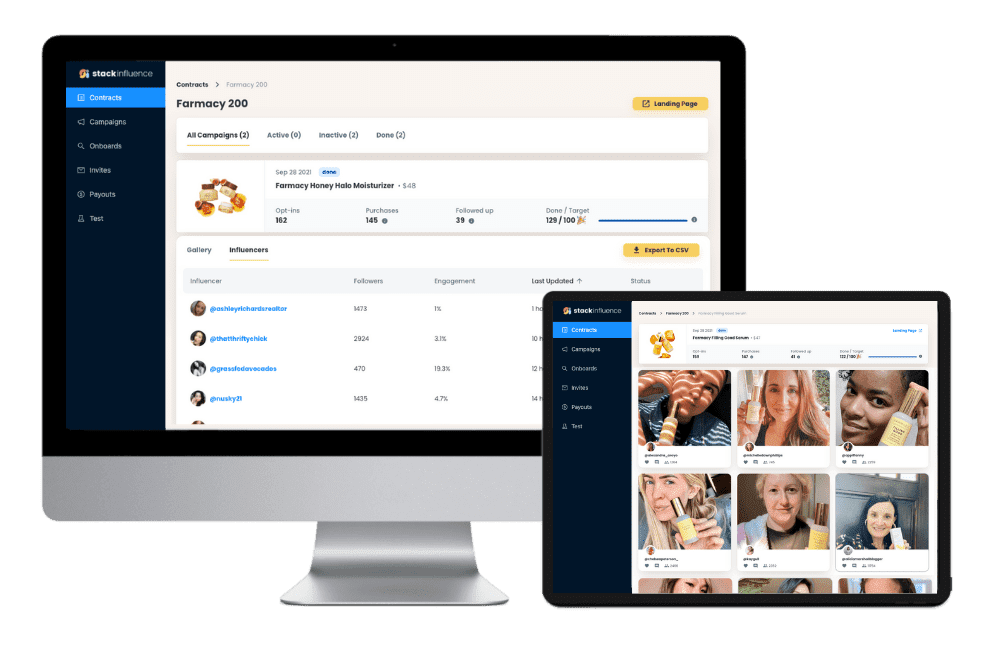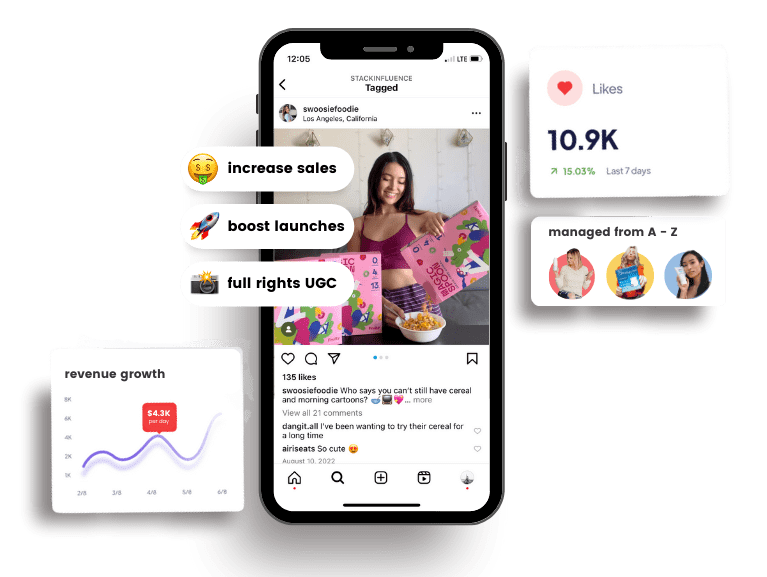Holiday Influencer Marketing Campaigns to Try for 2025
15th
October, 2025
Influencer Marketing
Amazon Marketplace
Artificial Intelligence
TikTok Tips
The holiday shopping season is a critical time for brands, and holiday influencer marketing campaigns are poised to be more impactful than ever in 2025. Consumers increasingly turn to social media and content creators for gift inspiration – nearly 9 in 10 shoppers say social platforms influence their holiday purchase decisions. In fact, 58% of holiday buyers planned to purchase products suggested by influencers during Black Friday/Cyber Monday. This shift toward influencer-driven shopping means that even small e-commerce brands (and Amazon sellers) can boost Q4 sales by partnering with micro influencers and leveraging authentic content. Below we’ll explore multiple holiday influencer marketing campaigns you can try for 2025 – from gift guide collaborations to UGC contests – along with tips to make them a success.
Shoppers’ behavior is evolving, and brands must meet them where they are. More than 21% of consumers plan to buy holiday gifts via social media platforms in 2025, almost double last year’s share. Younger generations especially trust creators: 73% of Gen Z consumers say they’ll make holiday purchases based on influencer recommendations. Influencer content doesn’t just reach people – it converts them. Adobe’s data from Prime Day 2025 showed influencers drove nearly 20% of online sales, second only to paid search, and their content outperformed traditional ads in driving conversions. In an era of ad-fatigue and ad-blockers, influencers provide the authenticity and social proof shoppers crave. Whether you’re an e-commerce giant or a small business, investing in holiday influencer marketing campaigns can help you stand out in the crowded holiday market, build trust with consumers, and ultimately drive more sales.
Holiday Influencer Marketing Campaigns to Try in 2025
Below are several holiday influencer marketing campaigns ideas – ranging from creative content collaborations to strategic promotions – that brands of all sizes can execute in 2025. These campaign ideas incorporate trends like micro-influencer engagement, user-generated content (UGC), social commerce, and more. Let’s dive in!
1. Influencer-Curated Gift Guide Campaigns

One effective holiday influencer marketing campaign is to have influencers curate gift guides featuring your products. Rather than a hard sell, creators share their genuine holiday picks and how your product fits as a perfect gift. For example, beauty brand L’Occitane’s Black Friday campaign focused on gift guides handpicked by influencers, with lifestyle creators posting Instagram Reels and TikToks highlighting favorite holiday products and exclusive deals. These influencer gift guides felt like friendly recommendations instead of ads, which helped build trust and drive clicks and sales. In fact, L’Occitane found that this approach of influencer-led storytelling “moved the needle” more than flashy discounts – it elevated brand perception and increased buyer confidence.
To try this, partner with influencers in your niche (from micro influencers to bigger creators) and have them create “Top 10 Gifts for ____” style content featuring your products. Ensure the posts feel personal and authentic – the influencers should explain why they love the items. Gift guide campaigns work well because followers see products in a relatable context, and they double as valuable content on blogs or social media. Not only can this boost holiday sales, but it strengthens your brand’s credibility through the influencer’s trusted voice.

Unlock the Power of Micro Influencers and Elevate your Brand Today!

2. Personalized Promo Codes and Affiliate Discounts
Another high-conversion idea is an influencer promo code campaign – give influencers unique discount codes or referral links to share with their followers. This tactic can create a sense of exclusivity and urgency (“use my code for 15% off – limited time!”) while also allowing you to track sales from each influencer. A good example is MyProtein’s Black Friday campaign, where the fitness brand provided each influencer with a personalized promo code for extra discounts on top of sitewide deals. Influencers integrated these codes into their content (like workout videos and product reviews), effectively turning them into enthusiastic affiliate sellers. The strategy worked because audiences trusted their favorite fitness creators’ recommendations – when told about MyProtein’s products plus an extra savings, it was an easy “yes” for consumers. The campaign drove urgency (with time-limited codes) and boosted conversions significantly.
For your own holiday influencer marketing campaigns, consider equipping influencers with special holiday promo codes (or unique affiliate links) to share during events like Black Friday, Cyber Week, or Christmas sales. This works for both e-commerce websites and Amazon sellers (who can use Amazon Associates or coupons). Make it worth their followers’ while – e.g. an added 5-10% off or a small free gift with code – and highlight that it’s exclusive via the influencer. The influencer’s personal endorsement plus a deal creates a powerful combination of trust + incentive, driving quick action. As a bonus, you’ll be able to measure ROI easily by tracking redemptions per code. Many small brands have seen great success using micro-influencers in this way, as it’s cost-effective and directly tied to sales.
3. UGC Contests and Giveaways with Holiday Hashtags
To spark maximum engagement and authentic buzz, try running a holiday UGC contest or giveaway in collaboration with influencers. The idea is to encourage followers (and the influencers themselves) to create content around your brand – often by posting a photo or video with a specific holiday hashtag – in exchange for a chance to win a prize. Holiday giveaways tap into the festive spirit and people’s love of sharing traditions. For instance, candy brand Haribo ran an Easter campaign challenging fans to “hunt the double yolker” in special edition packs. They hid a rare candy in some bags and prompted customers to post on social media with the hashtag #HuntTheDoubleYolker if they found one. This giveaway contest motivated tons of user-generated content, as people shared photos of their candy finds hoping to win a prize (a family holiday trip). The result was a surge of organic awareness; as Haribo demonstrated, competitions are very effective in getting people to create UGC and share images with a branded hashtag, thus raising brand visibility in an organic way.
For the 2025 holidays, you could run a similar campaign: partner with a few influencers to announce and promote the contest (ensuring the rules are clear), and have participants post their entry content on Instagram, TikTok, etc. using your campaign hashtag. Ideas include a Christmas photo contest (e.g. best “ugly sweater” pic featuring your product), a New Year’s challenge (e.g. creative video using your product in a celebration), or a simple giveaway where anyone posting with the hashtag is entered. Influencers can kickstart the UGC by posting their own examples. This style of holiday influencer marketing campaign not only generates a library of authentic content for your brand, but also leverages the participants’ networks – expanding your reach as people tag friends or share entries. Just be sure to offer a relevant, exciting prize (bundle of your products, a big gift card, or experience) to entice involvement. UGC contests are a win-win: consumers have fun and possibly win something, while your brand gains social buzz and content that can be repurposed in marketing.
4. Early Bird Product Seeding with Micro-Influencers (Build Buzz Before Peak Season)
Don’t wait until November to start your holiday influencer outreach. A major trend for 2025 is starting holiday campaigns early – as soon as mid-year – to capture shoppers who now search for deals and gift ideas well before fall. Nearly 60% of consumers begin holiday shopping before October, and many begin hunting for deals in August. By launching influencer partnerships early (think Christmas in July), you can build up interest and content ahead of the rush. Smart brands are seeding products with micro influencers in the summer months, so that by the time Black Friday rolls around, shoppers have already seen authentic reviews, unboxings, and gift ideas featuring those products. Essentially, early micro-influencer campaigns plant the seeds of desire and social proof in advance. When an influencer shares a genuine review or holiday “sneak peek” of your product in September, their followers might add it to wishlists long before the holiday crunch – giving you a head start on the competition.
Working with micro-influencers (creators with a smaller but highly engaged following) is especially useful for early campaigns. Micro influencers often will collaborate in exchange for free product or a modest fee, making this approachable for small brands. Despite their smaller reach, their content can have outsized impact due to strong audience trust and high engagement rates. In fact, micro-influencers tend to see around 5–20% engagement from their followers, far above the ~2% typical of macro influencers. They also generate excellent ROI for brands – one analysis showed micro/nano-influencer campaigns delivering roughly a 20:1 ROI, compared to ~6:1 for campaigns with big influencers. The reason? Micro creators are seen as authentic peers, so their followers are much more likely to listen and act on recommendations, and they’re much cheaper to work with, so your marketing dollars go further.
To execute an early-bird micro-influencer campaign, start identifying creators in your niche by late spring or early summer 2025. You might send them an early batch of your holiday products or a “sneak peek” item to try out. Let them know they’re among the first to experience this upcoming holiday launch – this often excites creators and makes them feel valued. As they post content over the summer and fall, that UGC (user-generated content) builds trust and anticipation among shoppers. Remember, authenticity is key: 55% of 18–34 year-olds (and nearly half of 35–54 year-olds) say they prefer to see real customer content and recommendations over polished ads. So the more real and relatable the influencer posts are, the better. You can amplify the best of these early influencer posts on your own channels later (for example, repost their review video in November with a “See why micro-influencer X loved this product!” caption).
Tip: For brands with limited in-house bandwidth, consider using a specialized micro-influencer platform like Stack Influence to streamline these campaigns. A platform such as Stack Influence can handle everything from finding and validating micro influencers to managing outreach, product shipping, and content tracking. In fact, Stack Influence is built for e-commerce businesses and even Amazon Marketplace sellers – it uses AI-driven tools to vet creators and allows you to trade your products for social promotions easily. Leveraging a service like this can make running a large-scale micro-influencer gifting campaign much easier, so you can focus on strategy while the platform handles the campaign logistics.
5. Influencer-Led Holiday Countdown or Advent Series
Everyone loves a good countdown during the holidays – it builds excitement and gives audiences something to look forward to each day. Brands can tap into this by creating a holiday countdown campaign in partnership with influencers. For example, consider an “Advent calendar” style campaign: each day leading up to Christmas, an influencer reveals a new product, deal, or tip. This approach was brilliantly executed by Alo Yoga in 2024. The athletic apparel brand released a limited-edition advent calendar filled with exclusive goodies, and had wellness influencers unbox one item each day on TikTok and Instagram. By having fitness and lifestyle creators share daily reveals of the calendar, Alo Yoga generated continual buzz – followers tuned in each day to see the next surprise. The content felt organic (influencers showed how each item fit into their own holiday routines), which kept it relatable and on-brand. The results were impressive: the social media buzz was huge, the advent calendars started selling out fast, and Alo Yoga saw millions of views plus a big increase in online engagement as the campaign rolled on.
You don’t have to sell an advent calendar to leverage this idea. Any brand can design a “12 Days of Christmas” (or 8 Days of Hanukkah, etc.) campaign where each day features a new piece of content or a special offer revealed by an influencer. For instance, a beauty e-commerce retailer might work with makeup influencers to do 12 days of holiday looks using different products – one look (with product highlight) each day. Or a food brand could do 8 days of holiday recipes with various foodie creators, each day unveiling a new recipe video incorporating the brand’s ingredient. Countdowns create a narrative that keeps audiences engaged over time, rather than a one-off post. They also encourage followers to check back frequently (“What’s today’s surprise?”), which is gold for social media algorithms and brand recall. To execute, line up a group of influencers (or one dedicated influencer) and plan the series of posts in advance. Align it with a hashtag (e.g. #12DaysOfHoliday or similar) and promote the series start beforehand to get people watching from Day 1. This type of holiday influencer marketing campaign not only drives sales through repeated product spotlights, but also fosters a festive connection with your audience as they join the daily fun.
6. Partner with Amazon Influencers and Storefronts
For brands selling on Amazon, collaborating with influencers through Amazon’s own channels can be a game-changer during the holidays. Amazon’s Influencer Program enables creators (from micro to macro) to set up their Amazon storefronts where they curate product lists and earn commissions on sales they drive. In holiday season, many influencers create special Amazon gift guides and idea lists (you may have seen hashtags like #AmazonFinds or #TikTokMadeMeBuyIt showcasing popular products). Getting your product featured by an Amazon influencer means tapping into a seamless shopping funnel: the influencer recommends it on social media, and followers can click straight to Amazon to purchase in one go. The trust the influencer has built transfers to your product, and because it’s on a familiar platform (Amazon), consumers feel safe buying immediately.
You can approach Amazon-focused creators in your niche and offer them your product to review or include in their holiday picks. Often, these influencers will include your item in their Amazon holiday gift guide or do a quick demo on TikTok/Instagram and then say “I added this to my Amazon storefront under Holiday Gifts – swipe up to shop!” The easier you make it for the audience to buy, the better. Some brands even arrange Amazon Lightening Deals or coupons that coincide with the influencer’s post to create urgency and a great bargain for viewers. Another angle is leveraging Amazon Live (as mentioned above) – some influencers on Amazon have shows where they cover various products; securing a slot in one of those holiday live segments can expose your product to thousands of ready-to-shop viewers on Amazon.
What’s great about Amazon collaborations is that they not only drive direct sales but can improve your product’s performance within Amazon’s ecosystem. The influx of external traffic and sales can boost your product ranking, making it more visible to the hordes of shoppers searching on Amazon during peak season. In other words, an influencer might bring you 100 sales, and those sales push your item up the Amazon search results, leading to even more organic sales. For Amazon sellers, this creates a powerful feedback loop. To maximize success, ensure your Amazon product listing is fully optimized (great images, reviews, A+ content) before the campaign hits, so that once the influencer sends people your way, your page converts them effectively. Also, consider giving the influencer an affiliate commission via Amazon’s program – it costs you nothing extra (comes from Amazon’s cut) and incentivizes the creator to pick and push your item. With so many consumers relying on Amazon for holiday shopping, integrating an Amazon influencer strategy into your holiday influencer marketing campaigns can significantly boost your Q4 results.
Tips for Successful Holiday Influencer Campaigns

-
Start Early & Plan Ahead
Don’t wait until Black Friday to kick off campaigns. Begin planning in Q3 and even launch some promotions in late summer or early fall. Brands that engage early capture deal-hunters before the peak – for example, seeding products with micro-influencers by August can create demand well before November. Spread out your content calendar to cover early birds and last-minute shoppers alike.
-
Focus on Authenticity and UGC
Audiences can tell apart a genuine recommendation from a scripted ad. Encourage influencers to be candid and creative, even if that means less “polished” content. Authentic, user-generated style content builds trust – 90% of consumers say authenticity is important when deciding which brands to support. Show real people using and loving your product.
-
Leverage Micro-Influencers
For small brands or niche products, a team of micro-influencers can often outperform one big celebrity. Micro influencers have highly engaged followers and offer a more relatable voice. They’re also budget-friendly, often trading content for product or a modest fee, leading to a stronger ROI on spend. Use them to target specific communities that align with your product (e.g. tech gadgets with a tech blogger, local foodie with a kitchenware item, etc.).
-
Use Multiple Channels (Omnichannel)
Don’t limit your influencer campaign to just one platform. Repurpose the content across Instagram, TikTok, YouTube, Facebook, and even your email newsletters or website. Consistent messaging across channels reinforces your campaign. For instance, an influencer’s unboxing video could be featured on your product page as added social proof. If you have physical stores, involve local influencers to drive foot traffic as well (e.g. “Available at my local XYZ store, go check it out!”).

Unlock the Power of Micro Influencers and Elevate your Brand Today!

With the right planning and creative partnerships, your 2025 holiday campaigns can cut through the noise and truly resonate with shoppers. From inventive gift guides and interactive live streams to authentic micro-influencer stories, there are many approaches to explore. The common thread is authenticity and strategy: meet consumers early, meet them where they spend time (social media and online communities), and give them content that adds value to their holiday experience. By doing so, your holiday influencer marketing campaigns can drive not only immediate sales but also lasting brand loyalty as you head into the new year. Here’s to making the 2025 holidays your most engaging and successful season yet, with a little help from influencers spreading the cheer!

By William Gasner
CMO at Stack Influence
William Gasner is the CMO of Stack Influence, he's a 6X founder, a 7-Figure eCommerce seller, and has been featured in leading publications like Forbes, Business Insider, and Wired for his thoughts on the influencer marketing and eCommerce industries.
Want new articles before they get published? Subscribe to our Awesome Newsletter.
stack up your influence
turning creativity into currency
our headquarters
111 NE 1st St, Miami, FL 33132
our contact info
[email protected]
stack up your influence
turning creativity into currency
our headquarters
111 NE 1st St, 8th Floor
Miami, FL 33132


